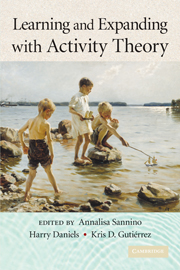Book contents
- Frontmatter
- Contents
- Contributors
- Editors' introduction
- 1 Activity Theory Between Historical Engagement and Future-Making Practice
- PART ONE UNITS OF ANALYSIS
- PART TWO MEDIATION AND DISCOURSE
- PART THREE EXPANSIVE LEARNING AND DEVELOPMENT
- PART FOUR SUBJECTIVITY, AGENCY, AND COMMUNITY
- 12 From the Systemic to the Relational: Relational Agency and Activity Theory
- 13 Expansive Agency in Multi-Activity Collaboration
- 14 The Communicative Construction of Community: Authority and Organizing
- 15 Research Leadership: Productive Research Communities and the Integration of Research Fellows
- PART FIVE INTERVENTIONS
- Bibliography
- Author Index
- Subject Index
14 - The Communicative Construction of Community: Authority and Organizing
Published online by Cambridge University Press: 05 June 2012
- Frontmatter
- Contents
- Contributors
- Editors' introduction
- 1 Activity Theory Between Historical Engagement and Future-Making Practice
- PART ONE UNITS OF ANALYSIS
- PART TWO MEDIATION AND DISCOURSE
- PART THREE EXPANSIVE LEARNING AND DEVELOPMENT
- PART FOUR SUBJECTIVITY, AGENCY, AND COMMUNITY
- 12 From the Systemic to the Relational: Relational Agency and Activity Theory
- 13 Expansive Agency in Multi-Activity Collaboration
- 14 The Communicative Construction of Community: Authority and Organizing
- 15 Research Leadership: Productive Research Communities and the Integration of Research Fellows
- PART FIVE INTERVENTIONS
- Bibliography
- Author Index
- Subject Index
Summary
I aim to accomplish two things in this chapter. First, I want to present what I see as the striking similarities between activity theory and our own somewhat different concept of coorientation (see Groleau, 2006, for a contrasting view). Second, and more important, I will delve into where I think our ideas diverge and, indeed, significantly so. I hope in this way to enlarge the dialogue, because taking account of similarities and differences is how we learn. This chapter should thus be read as one more episode in an ongoing dialogue that began more than a decade ago, in Albuquerque, New Mexico.
POINTS OF AGREEMENT
Probably the most important insight that activity theory has emphasized is that, when we turn to examine any segment of behavior, individual or collective, we should bear in mind its embedding in a heterogeneous material, technical, social, and cultural world. It is always tempting for an empirically oriented researcher to focus in on some single aspect of the situation, the discourse of people at work, for example, and in privileging their concentration on that dimension, to set the rest aside as irrelevant to the task at hand. Activity theory rejects, in my opinion correctly, this narrowing down.
My intuition, in this respect, dates from my years as a television producer. In the television studio, the producer was never confronted with a choice of less than two (often three or more) alternative images of the action unfolding before the cameras.
- Type
- Chapter
- Information
- Learning and Expanding with Activity Theory , pp. 228 - 239Publisher: Cambridge University PressPrint publication year: 2009
- 11
- Cited by



